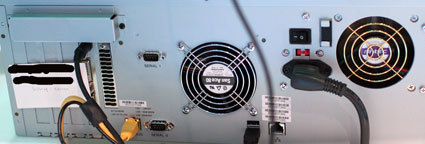GDC 2006: Playstation 3 without HDMI
San Jose (CA) - Last week, Sony announced to launch its Playstation 3 in November and blamed the delay on technical problems such as the ongoing work to finalize Blu-ray's copy protection technology AACS. At GDC we got a glimpse how far the PS3 may be still away from production, as Sony was not able to run the console through HDMI at 1080p resolution.
One of the reasons to buy an Xbox 360 or an upcoming Playstation 3 is the fact that Microsoft and Sony promise the beginning of a high definition gaming era - a new stage for gaming that will bringer higher-quality audio and video to the screen. On 15 March, Sony conceded that it was forced to delay the launch of its contender because a series of technology delays. The console has been touring the country for more than a year - without being actually demonstrated in detail - and it was our expectation that we will see at GDC a version that would come close to a production unit - as Sony will have to start mass-producing the console in late summer.
In fact, Sony had a few consoles on display at GDC, which were demonstrating video and audio demos. But surprisingly, these boxes were showing hardly any of the PS3's expected capability, including a screen feed that was not delivered through the HDMI interface, but through Sony's "AV MULTI OUT" connector,which has S-Video and component analog ports.
Two different PS3 prototypes were used in the demos; one was a slimmer box with dual HDMI outputs, while the other was a PC case with a video card in the back. Both devices were connected to identical Sony model television sets, which had HDMI ports.
Sony Playstation 3 graphics demo unit
All graphics demos were played on the slim boxes, while the audio demos were played on the larger PC-sized boxes. The graphics demo units were connected to the televisions via Sony's AV Multi-Out connector (black cable in photo), which is an analog connector that can split into S-Video or RCA connectors. The two HDMI ports right below the AV Multi-Out port were unused.
Of course, we were interested in why Sony did not run the units with HDMI. There may be an obvious explanation, but we received some surprising answers from Sony's staff. First, we were told that it isn't easy to get a hold of HDMI-equipped TVs. We found this to be very strange, because after all we were at the Sony booth and all the television sets had HDMI inputs. On the second try, we were told that the reason for not using HDMI was that Sony did not have any HDMI cables and that "they are difficult to find". Matt Butrovich, a former intern with Tom's Hardware and who walked the show floor with us, offered the staff to use one of the HDMI cables he actually had in his car and connect the PS3 with the TVs. Sony officials turned down the offer and we were left without seeing the demos in HD.
Get Tom's Hardware's best news and in-depth reviews, straight to your inbox.
Somehow we feel that there was another reason for not showing the PS3 with HDMI. In fact, the explanation could be as simple as the PS3's HDMI wasn't compatible with the HDMI spec integrated in the TVs. Recently it was announced that the PS3 will use HDMI 1.3, which will use an expansion of the audio channels and offer Dolby TrueHD as well as DTS-HD. Current TVs generally use HDMI 1.1, which do not support these extensions and create significant audio noise when connected to a HDMI 1.3 device.
Audio demo unit (black cable to the bottom-right of the fan is USB)
In the end, we do not know the real reason of avoiding HDMI in the GDC demonstrations. But it certainly highlighted that Sony has still work to do - not only to finalize the AACS spec, but also to accelerate the availability to HDMI 1.3 and to educate customers that they only can run HD video and audio if they have a HDMI 1.3 capable TV.
Humphrey Cheung was a senior editor at Tom's Hardware, covering a range of topics on computing and consumer electronics. You can find more of his work in many major publications, including CNN and FOX, to name a few.

